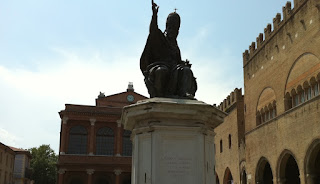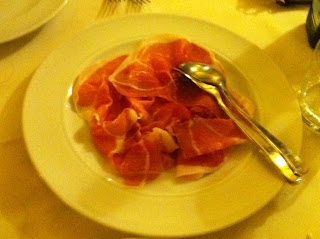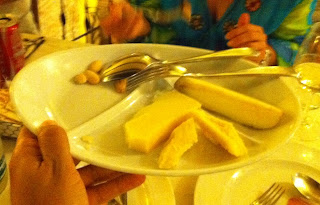Yesterday we relaxed on the Adriatic Riviera. Today we will walk into Rimini's city center, which in most Italian cities is where you find the Duomo (cathedral), piazzas, and history.
I had been skipping breakfast pictures, but I thought I would show my mother that my breakfasts have narrowed down to fresh fruit and muesli.
Right outside our front door is the Parco Fellini, which features this rather lovely fountain. I had to frame tightly, which is a shame, because a more full view would be prettier if there was not an incredibly ugly billboard-sized orange Cartoon Festival advertisement just to the right.
Walking up Corso Giovanni XXIII, He was the Pope from 1958 to 1963. He is not a local boy, but he must have done something for Rimini to get a street named after him.
Piazza Tre Matiri, Rimini's main square. This was called the Piazza Grande until after World War II, when they renamed it, "Three Martyrs Square," after three resistors who were hanged here by retreating Nazi's.
The history of this place is fascinating and complicated. At the crossroads between Northern and Southern Italy, it has been sacked, conquered, reclaimed, and basically passed back and forth between dozens of powers. We are talking the Etruscans, Umbrians, Greeks, Romans, Popes (when they had armies), Gauls, Austrians, Napoleon, modern Italy, the Nazis, and then Italy again. Not an important city, but a city that was always in the way of someone's target.
The history of this place is fascinating and complicated. At the crossroads between Northern and Southern Italy, it has been sacked, conquered, reclaimed, and basically passed back and forth between dozens of powers. We are talking the Etruscans, Umbrians, Greeks, Romans, Popes (when they had armies), Gauls, Austrians, Napoleon, modern Italy, the Nazis, and then Italy again. Not an important city, but a city that was always in the way of someone's target.
Gaius Julis Caesar, at the Piazza Tre Martiri. Hey, if you were going to make a statue from the laundry list of those who marched troops through your city, why not go with Caesar?
The town is decorated, perhaps I should have typed, "decorated," by gigantic, pink, plastic snails. I had to get on my knees to frame the clock tower behind them. Photographical dedication should be without limit.
The tabloida Italiano.
Just outside the piazza was this post office, which currently hosts immigration-related graffiti. We did walk through a few blocks that were entirely Asian and then entirely Muslim to get here. We have a hunch this relates to them.
Us with the Arco d'Augusto. Built in 27 BC, during the first year of the reign of the first Emperor of Rome, Caesar Augustus.
Just in case it is not fresh in your memory, as it was not in mine, Julius Caesar was never Emperor of Rome. Rome was not an empire under his reign. After his death, there was civil war until his chosen heir, grand-nephew Gaius Octavian, rose to prominence. When he died he even gave Octavian his name, who then received the honorific Augustus when he became emperor. That is how the man who built this arch went from being Gaius Octavian to Gaius Julius Caesar to Gaius Julius Caesar Augustus.
For the record, Caesar Augustus probably never visited this city. He simply wanted arches built throughout the Empire to commemorate the beginning of his reign.
Just in case it is not fresh in your memory, as it was not in mine, Julius Caesar was never Emperor of Rome. Rome was not an empire under his reign. After his death, there was civil war until his chosen heir, grand-nephew Gaius Octavian, rose to prominence. When he died he even gave Octavian his name, who then received the honorific Augustus when he became emperor. That is how the man who built this arch went from being Gaius Octavian to Gaius Julius Caesar to Gaius Julius Caesar Augustus.
For the record, Caesar Augustus probably never visited this city. He simply wanted arches built throughout the Empire to commemorate the beginning of his reign.
Originally built as an arch, the walls were added in the middle ages. And I would bet the brick above as well. This means that the white stone in this picture is from 27 BC, while the red brick is from the 1500's. The 500 year old brick would seem old if it was not next to the 2,038 year old stone.
The Tempio Maletestiano. Officially named for St. Francis, it is generally called Maletestiano after the wealthy nobleman Sigismondo Pandolfo Maletesta, who commissioned its construction.
The front of the Tempio Maletestiano. Built in 1450, it definitely lacks the flair of the Renaissance that came later. The term Dark Ages is a bit rough, but understandable. Maletesta has a small castle on the other side of town. We are skipping it.
In a few spots in Rimini's center, they fence off a digging that shows you the original stones of the Roman forum which sat here two thousand years earlier. Not much to look at, I know, but interesting to be reminded that today's city rests upon its ancestor.
Over at the Piazza Cavour, home to the theater and the Fontana della Pigna.
Pope Paul V has sat here since 1614. Interesting that the Popes built monuments to themselves as eagerly as other rulers.
Barbie at the Fontana della Pigna. We saw people filling water bottles here. You can see from the design it was meant to deliver water, not display it. I cannot remember why, but at the Vatican they told us that acorns represent the Vatican, which would explain the acorn atop the fountain.
The fountain with the theater behind it. As I take this picture, Barbie has walked into the gelato shop to the immediate right.
A sign explaining the snails. As I take this picture, Barbie is buying the gelato.
I passed on gelato, instead getting lemon sorbet.
Barbie got coffee and bacio gelato, which is hazelnut and chocolate.
The Ponte di Tiberio. Began under Augustus in 14 AD, completed by Tiberius in 21 AD. Some Riminesi tell a tale that this is the Rubicon river, which Julius Caesar historically crossed with his legion in act of treason, leading to his eventual triumph. It is not. Historians have located that river a few towns over. Still, it is a nice story for the locals to tell.
For the first time we walked out of hour hotel and headed south along the beach, where we soon spotted this gigantic camera sculpture. Note Barbie is holding up her camera.
A little bit of America for lunch.
We napped, showered, watched some BBC news, and prepared for dinner.
On the way to dinner, I got very lucky with the sunset.
We again followed Franco driving Livinia's car to another town. This time we arrived in Santarcangelo, a small town of 20,000 people with medieval walkways up the hillside and a clock tower on top of the hill.
We again followed Franco driving Livinia's car to another town. This time we arrived in Santarcangelo, a small town of 20,000 people with medieval walkways up the hillside and a clock tower on top of the hill.
A view in Santarcangelo.
The sun is recently set, getting us to that magical hour for photography.
An artist has placed hanging pieces around Santarcangelo. This one of a hanging alarm clock makes the Waste, while the briefcase and rotary phone do not.
As the sun sets, the views become more special.
The clock tower at the perfect time of day.
A quaint hilltop street.

We arrive at Ristorante Lazaroun.
Yet again a meal that borders on ridiculous. I took pictures of the menu so that I have a chance to tell you what you are seeing. Also, the light was low and I had to take pictures quickly, as this was family style and people did not want to wait for me to get that ideal shot.
Prosciutto di parme e fichi caramellati. That means the three bowls of caramelized figs above...
...get mixed with this prosciutto...

...to form this little fig and ham burrito. And here I owe a name check to John Gillis, who was once the chef at The Girl And The Fig and fed figs to Dave, Marta and I that were simply astounding, selling me on the concept of ordering the fig whenever I see it on a menu. For the record, I did not order this, even if I just made it sound like I did. Someone else selected it.
Fiori di zucca fritti; fried zucchini flowers.
Flan di melanzanne su vellutata di pomodoro; eggplant flan. This was the one thing that I ordered tonight, and I loved it.
Gorgonzola; a house specialty, aged in the cellar below.
Lasagnetta gratinata alla mediterranea; you need no translation for that.
A vegetable plate.
Passatelli asciutti al ragu bianco di vitello e asparagi; a special pasta made only here, that I cannot describe to you because it is very unique. Visit Rimini if you want a taste, or google it and read how it is made.
Tortellini di marscapone ai funghi porcini; delicious but needed a dash of parmigiano reggiano, if you know what I mean.
Tortino di amaretti e ciccolato con crema gialla.
Cialsa con crema di mascarpone e frutti di bosco.
Semifreddo ciccolate e torrone.
Panna cotta con le more.
Semifreddo ghiacciato al lime; an amazing lime dessert.

The outside of the restaurant. We stayed so late that the lights inside turned off as we walked away.
Time for bed. We drive to Firenze (Florence) tomorrow.















































No comments:
Post a Comment